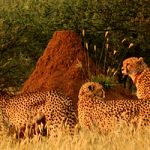Erindi’s male Serval released after a VHF collar was fitted.
Serval Leptailurus serval is known to occur in Namibia only narrowly in the north east of the country. The species is most often associated with swamp areas as close proximity to water is an essential habitat requirement. Good plant cover in the form of tall grass, reeds or riparian vegetation is also a vital habitat requirement for Serval to hide in during the day and as cover for rodents which are their primary food source.
Serval is thought not to occur in the Nama Karoo biome which covers large parts of the western section of Southern Africa including much of Namibia and Erindi Game Reserve.
Known distribution of serval and position of Erindi Game Reserve:
Photographic evidence from Erindi prior to 2006 confirmed that wild Serval was present in the area but this was thought to be a once-off case.
In late 2007, a leopard kill was found and identified by the skull as that of another Serval on Erindi Game Reserve. During 2008 & 2009 serval sightings were reported by numerous guides on game drive and a large individual was spotted by Paul Joubert, CEO of Erindi and chopper pilot during an aerial game count census.
The “once-off” case of a serval sighting on Erindi occurred more regularly during 2010 and 2011 and more than 10 people reported confirmed sightings throughout the reserve of this long-legged feline with a short tail and golden coat painted in unusual spots and stripes!
Incredibly in spring of 2011, more than 500km from it’s known range, a healthy male Serval was captured and the Erindi team decided it was worth fitting the individual with a VHF tracking collar to follow his movements. Once immobilised by the vet, all measurements, weight and important features of the male serval were recorded and everyone at Erindi at the time had the opportunity to see the beautiful creature. Average weight for a male is given as 11.13 kg and Erindi’s serval weighed in at 11kg!
Serval feeds on a diet consisting almost solely of rodents:
67% of the 12 species of rodent found in the diet of serval within their natural distribution range exist on Erindi. An amazing diversity of 24 rodent species that can be utilised by serval occur on the reserve in high numbers and this could be a contribution to the healthy male captured and other individuals in the area.
It is not known where Erindi’s serval population has come from but it certainly appears to be more than a once-off sighting and it does seem that a natural population is somehow establishing itself. Between 1987 and 2010, there was a definite overall increase in annual rainfall and during 2010 / 2011, some areas of Erindi had over 1 000mm of rain, 600mm more than average annual quota.
This has left dams full and excellent vegetation cover year round possibly contributing to a suitable environment for serval to survive, but is this just temporary?
Erindi’s collared male will be followed carefully and attempts will be made to identify other individuals. Status and success of serval in the area can then be established.
Natasha Britz
PHOTOGRAPHS by Natasha & GP Britz





